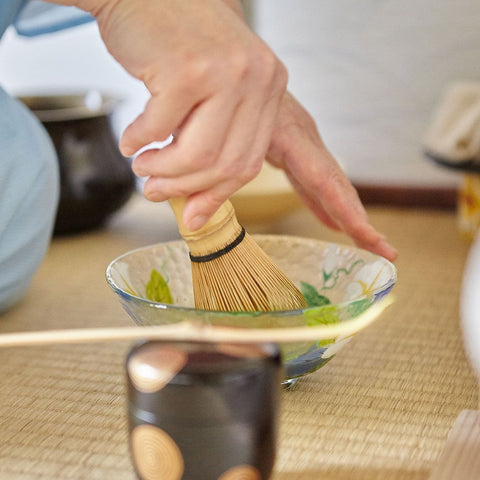How Japanese Artisans Make Chasen Bamboo Whisks?

Matcha is produced through the laborious process of stone-grounding Japanese green tea leaves. Match-making is a comprehensive process that requires much attention. Before the harvesting process, the tea leaves are kept in the shade for around 3-4 weeks to increase their chlorophyll content and antioxidants.
In order to have a real matcha experience, it is highly recommended to prepare it using the authentic Japanese matcha tea set that includes crucial instruments like a Chasen bamboo whisk. If you don’t know what a Chasen bamboo whisk is? Then let us give you all the basic details about this tool.
A chasen bamboo whisk is a traditional tool used for preparing matcha, a type of Japanese green tea. It is made from a single piece of bamboo and consists of numerous thin tines that are intricately woven together to form a delicate, yet sturdy, whisk. A matcha made with chasen is essential a tool for creating a frothy and smooth cup of matcha, as it helps to mix and aerate the tea powder with hot water, creating a fine and creamy consistency. Without a chasen bamboo whisk, it can be challenging to achieve the ideal texture and taste of matcha.
Just like matcha, the creation of the chasen bamboo whisk is a meticulous process. These whisks are handcrafted by skilled artisans, who have mastered the art of bamboo weaving to create these beautiful and functional tools. In this blog, we will explore the process of how Japanese artisans make masterpieces Chasen bamboo whisks.
Step 1: Harvesting and Selecting Bamboo
The first step in making a chasen bamboo whisk is to harvest and select the bamboo. The artisans carefully choose the bamboo for their whisks, looking for specific qualities such as thickness, straightness, and color. The bamboo must be free of knots, cracks, or other imperfections that could affect the final product’s quality.
Step 2: Cutting and Splitting Bamboo
Once the bamboo is selected, it is cut into suitable lengths for making the chasen whisk. The bamboo is then split into thin strips using a sharp knife, usually by hand, following the natural grain of the bamboo. This process requires great skill and patience as the artisans must ensure the strips are thin and even in thickness.
Step 3: Shaping the tines
The next step is to shape the bamboo strips into the tines of the whisk. The artisans use a heated metal rod to soften the bamboo and bend it into the desired shape. They then carefully shave the edges of the bamboo strips to create fine and sharp tips for each tine. This process takes considerable time and effort to achieve the desired shape and curvature of the whisk’s tines.
Step 4: Weaving the Tines
Once the tines are shaped, the artisans begin weaving them together to form the Chasen whisk. They interlace the bamboo strips in a specific pattern, ensuring that each tine is secured in place and creating a sturdy yet flexible structure. This process is done entirely by hand, and the artisans must pay close attention to the tension of each tine to achieve the right balance of flexibility and strength.
Step 5: Final Touches
After the tines are woven together, the artisans make final touches to the Chasen whisk. They trim the tines to ensure they are all the same length, and they smooth out any rough edges or imperfections. Finally, they soak the Chasen whisk in hot water to allow the bamboo to set and hold its shape.
In Conclusion,
The process of making a chasen bamboo whisk is a labor-intensive and intricate craft that requires skill, patience, and attention to detail. Japanese artisans have been perfecting this art for centuries, and their expertise is reflected in the quality and beauty of each chasen whisk they create. A chasen is an essential tool in preparing high-quality matcha, and using a handmade chasen whisk enhances the experience of the tea ceremony and elevates the flavor and texture of the tea.




